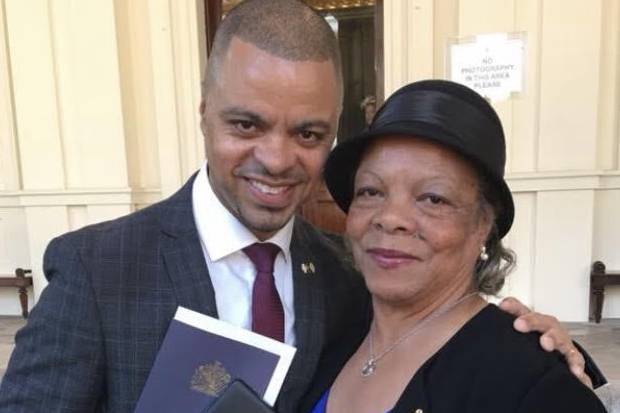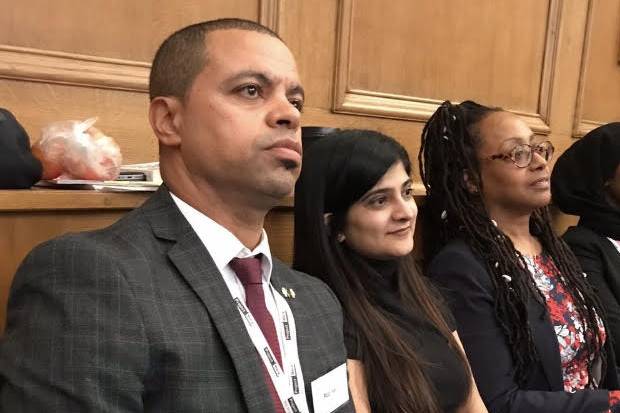Civil Service
|
|
Getting under the skin of bias
Blog posted by: Rob Neil, 29 January 2020 – Categories: A great place to work, Diversity and inclusion, Year of Inclusion.

Rob Neil with his mother at Buckingham Palace in May 2018, after receiving an OBE for "services to race equality across the Civil Service and in the community"
Following the publication of the Civil Service Diversity & Inclusion Strategy in October 2017, many of us embarked on a journey in awareness training. Indeed, some of us are now doing more than ever to understand, challenge and positively transform, our own personal biases.
Some of us have taken a deeper interest in the annual People Survey, and those results continue to inform strategy in a significant way. For example, in one department an increase in discrimination, bullying and harassment scores led to mandatory training in ‘How to manage Bullying’ and a subsequent Civil-Service-wide review.
Some of us have attended L&D activity aimed at ventilating a conversation about difference and encouraging listening more intently to the lived experience of those who have felt excluded by others’ inappropriate behaviour of others. The MoJ’s ‘Let’s talk about Race’ workshops, which began in 2015 via their Project Race Team, are a case in point. Similar conversations about race are now being rolled out in numerous departments, and a version was run at last year’s Civil Service Live events.
We have also seen a recent rise in membership of cross-government diversity networks, and a more serious attempt to professionalise them in support of the D&I Strategy.

Rob Neil at the MoJ Senior Civil Service Conference, for which he designed a Race Equality breakout session
Cultural intelligence
So, what can we do next to support people, encourage real behaviour change, and inspire progressive attention to the way we work?
I think the answer is rooted in increasing our cultural intelligence [CQ].
To quote H.H. Ang and K.L. Lee (2003), CQ is “the capability of an individual or group to adapt and operate effectively in a diverse range of cultural contexts, including national, ethnic, organizational, generational and departmental.”
When we help individuals improve their CQ, it enables them to consciously identify their biases and determine effective strategies for managing them. As we build our collective CQ, we learn to move from reacting unconsciously to taking more conscious, intentional actions aimed at progressive cultural change. CQ is how we can liberate ourselves from our biases.
Increasing our CQ
Here are three essential stages to help increase CQ and create a healthy environment for positive cultural change:
1. Create a safe space.
This may sound basic, but it is often overlooked. For example, if we are to facilitate healthy conversations around unconscious bias, people need to feel that they can share their personal truth and real experiences without backlash or judgment. Without that fundamental safety there will never be full disclosure and dialogue is always compromised. The need for critical conversations may surface, discourse never really gets under the skin and, ultimately, people walk away feeling discouraged, frustrated and, in some cases, even angrier.
How do you create a safe space?
You begin, as a collaborative group by establishing a clear set of rules, e.g. listening to learn, being fully present, establish and maintaining a no judgment zone, inviting positive intent and nurturing a willingness to be part of the solution. You then hold each other accountable for honouring those collectively agreed rules. Then by noticing, practicing and sharing each of the above, your safe environment builds trust. The richness of conversations that flow from this safe and trusted environment inspires teachable and learning moments. The rest is a journey.
2. Acknowledge fears
Many of us avoid challenging conversations because of fear. We may feel afraid of saying the ‘wrong’ thing, appearing biased or sometimes simply having to talk about a topic that makes us uncomfortable. Acknowledge the fears. Know that it’s normal to have these feelings. Commit to creating an atmosphere of learning and trust, so these fears do not hinder any capacity to participate, explore and learn.
How do you acknowledge fears?
Having created a ‘safe space’, invite people to share their truth, and remind everyone on the journey that even when the fear departs, they may still feel a level of discomfort. That’s ok, that’s because we’re all still learning, and by increasing the challenge and support in equal measure, we encourage advocacy and increase levels of engagement on the journey ahead. Together we can all support the change we wish to see.
3. Name it
Often we discuss unconscious bias in broad and generic terms, and end up dancing around the real issues within our working environments. Sometimes we need to name and confront those problems directly. What is the ‘it’ for your organisation? What are the biases in your part of the organisation? What does power look and feel like? Is it gender bias? Is it ageism? Is there a dominant culture and are different ethnicities disadvantaged?
How can we name it?
We must be big enough and brave enough to invest in expertise and resource talented teams capable of amplifying the voice of the under-represented. We need to give urgent attention to establishing representative staff networks as business critical entities. The potential for aligned and appropriately resourced staff networks to support transformation across the Civil Service is incredible.
During this ‘year of inclusion’, culturally intelligent leaders will empower others to engage and bring all of their innovative best into the workplace. Ultimately, it will be our collective ability to face our challenges together, respond to ground truth and increase our cultural intelligence, that will determine how ‘brilliant’ we become.
You may also be interested in:
- Civil Service Awards 2019 - Week of Winners: Diversity & Inclusion Award
- Civil Service Year of Inclusion - What inclusion means to me... Mark
- A look back at 2019 – Civil Service Race Champion Richard Heaton
A look back at International Day of Persons with Disabilities 2019
Original article link: https://civilservice.blog.gov.uk/2020/01/29/getting-under-the-skin-of-bias/


